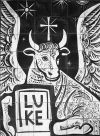
The Gospel of Luke
Jesus and the Temple: Lk 19,41-48
Back in 13,34-35, Jesus made a prophetic lament over Jerusalem which anticipates his entrance (13,35 and 19,38). Now this is picked up and renewed as Jesus laments over the city in verses 41-44. This follows the Pharisees' comments in verse 39 and their concern about the political consequences of Jesus's procession. Now they are told not to prefer the Pax Romana to the true peace of Jesus which was promised in the infancy stories (1,79.2,14) (even though Jesus recognises that he will be a source of division (12,51).
The terms used by Luke in verses 43 and 44 echo the Greek Old Testament and so need not be a direct reference to the Roman destruction of Jerusalem in 70AD. They are just a prophetic warning.
Prophetic actions and prophetic warnings continue in verses 46 to 47 as Jesus enters the Temple. This is what links the two parts we are reading: Jesus as prophet is issuing his warnings.
The appearance in the Temple echoes the sudden appearance of the Lord in the prophet Malachi in Mal 3,2 - almost the last words of the Old Testament. The Temple has already had its place in the infancy stories when Jesus comes to his Father's house in 2,49.
In verse 46, Luke omits the reference to a house of prayer for all peoples which Mark includes from Isaiah 56.7. Luke is here concerned with Judaism only.
As we have seen in the overview, verses 47-48 form a bracket with 21,37-38 around Jesus' teaching in the Temple. This teaching now follows in chapters 20 and 21.
19,47-48 set the scene for what follows. 20,1 will pick up on 19,47 repeating that Jesus is teaching in the Temple.
19,48 tells us that the people were spellbound (NRSV) by Jesus' words. There lies the authority of Jesus for the people. His authority for the leaders is instead about to be challenged (20,2).
We can now return to the main page.
